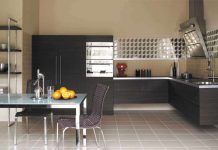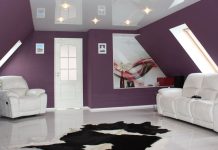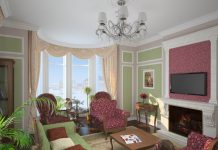According to the Japanese, houses, the interior of which is made in compliance with the traditions of this eastern country, are able to heal the souls of people, bringing peace and tranquility into consciousness. The Japanese style in the interior means a minimum of walls and partitions in the living space. Extra objects not only interfere with people physically living in the apartment, but also harm consciousness.
The Japanese style in the interior decor provides for the replacement of internal walls with light sliding screens consisting of a frame and rice paper stretched on a base. The beauty of the screens is given by paintings in oriental style and images reflecting the flavor of Japan. Lightweight screens are specially designed to divide the space into different zones, they move easily, creating an effect of novelty and surprise in the room.
Lighting solutions not only complement the lightness and lightness of the interior in oriental style. Lamps play their own special role in the decor of the interior of a Japanese house. The light seems to pass through the thin paper of the screens, giving the whole room a unique flavor, so inherent in the East, from the point of view of Europeans. The lamps are also used for zoning the room, which is decorated in Japanese style.
Creating a Japanese interior does not involve the use of paper wallpaper. As a rule, light beige paint is used to decorate the walls. Considering that design the Japanese style should not have many interior items and furniture, it is practiced to replace traditional cabinets with open structures, shelves and niches. This allows optimal use of space and the use of such structures for storing clothes, books and other household utensils.
The main open niche, called the “tokonoma”, should be in a prominent place in the house. According to the Japanese, tokonoma symbolizes the central place in the whole dwelling. Various household items are not stored in this niche. Here it is customary to store valuable works of art or ikebana for the owners, symbolizing bringing all kinds of benefits to the owners and many years of a healthy life.
Window openings in housing are not just protection from the weather or street noise. Windows for the Japanese are a kind of spiritual connection with the surrounding nature. The Japanese interior is characterized by the use of window structures with the use of wooden materials, as the most natural and close to nature. If the windows are made of artificial materials, then the frames are decorated with natural materials as much as possible.
As we have already said, rooms decorated in Japanese style should not be overloaded with furniture and interior items. Instead of the usual beds for us, the Japanese prefer mattresses stuffed with straw. Soft mattresses are thrown on top of such “beds”. During the day, these capes are removed into special niches designed for their storage. Straw materials not only help to maintain posture during sleep, but also help to create a special microclimate in the room, which has a beneficial effect on the human body.
All the furniture in the room, decorated in Japanese style, has elegant shapes and small sizes. Low sofas and low tables are traditionally placed in Japanese living quarters. This is due to the fact that in Japanese dwellings it is customary to sit on the floor or squat both during the traditional tea ceremony and during the reception of guests. In the same position, food is taken or books are read. Tea sets, ceramics, various figurines give the oriental house a special flavor and elegance. Often, special caskets inlaid and painted by craftsmen are used to store valuables.
Chopsticks, widely known to us after the appearance of Oriental cuisine restaurants, perform not only utilitarian functions in the Japanese house. Sticks with a special painting are stored on open shelves and also decorate the interior, made in Japanese style. A special aura is created in the house by the finest aroma, which exudes special candles and incense.












